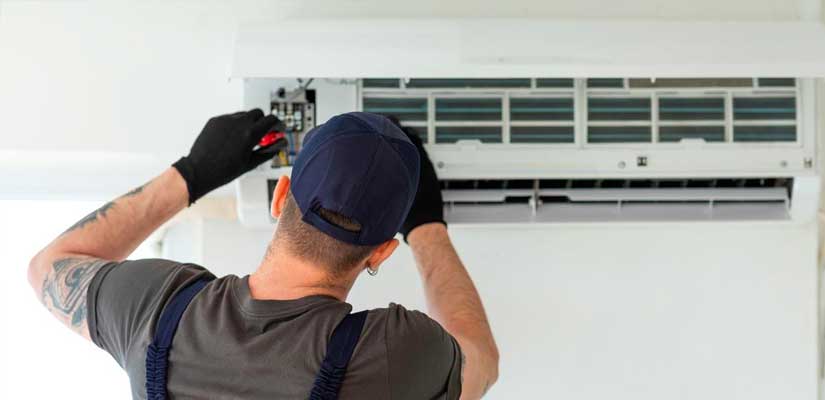Maximizing Energy Efficiency:
By keeping up with routine maintenance, you can keep the VRF system running at its most efficient. Over time, dirt and debris can accumulate on components like fans, coils, and compressors, making it harder for air to pass through and heat to be exchanged. As a result of having to work harder to clear the accumulation, the system is less efficient and uses more energy. The system can run more efficiently and use less energy, leading to lower power bills, if these components are cleaned and inspected during maintenance visits.
System Life Extension:
To make VRF systems last longer, routine maintenance is essential. Systems that are not properly cared for can experience early wear and tear, which can result in expensive repairs or even system failure. Regular inspections and quick fixes for little problems are what make up maintenance. This helps keep the system running well for years to come and prevents serious faults. Not only does this prevent the hassle and cost of replacing the system too soon, but it also saves money on repairs.
Ensuring Indoor Air Quality:
By regulating the air’s temperature, humidity, and ventilation, VRF systems are crucial in preserving IAQ, or indoor air quality. But, indoor air quality (IAQ) and occupant health can be compromised if coils and filters are not cleaned frequently; they may become habitats for allergens, bacteria, and mold. Filter replacement and coil cleaning are part of the scheduled maintenance that keeps impurities from accumulating and maintains healthy indoor air quality. Poor indoor air quality (IAQ) can have an effect on both staff productivity and customer happiness, making this an especially important consideration in commercial buildings.
Minimizing System Downtime:
Unanticipated malfunctions have the potential to halt operations, leading to downtime and, ultimately, lost income and productivity. Preventing system failures and unscheduled shutdowns is possible through routine maintenance, which helps find and fix possible problems before they become big problems. Businesses can reduce downtime and keep customers’ comfort levels under control by doing maintenance during off-peak times or during certain seasons.
Satisfying Warranty Requirements:
In order for the manufacturer’s warranty on a VRF system to stay valid, it is necessary to perform regular maintenance. The owner would be fully liable for any repairs or replacements needed if the guarantee was nullified due to noncompliance with these maintenance standards. Property owners can safeguard their investment in the VRF system and make sure they comply with warranty requirements by scheduling regular maintenance visits with qualified workers.
Maximizing Cost-Effectiveness:
Conducting routine maintenance may result in initial expenditures, but it ultimately leads to savings in the long run. Maintenance helps lower operating expenses by maximizing energy efficiency, avoiding expensive repairs, and extending the lifespan of the system. Proactive maintenance also helps owners plan ahead for maintenance costs so they don’t have to panic to pay for costly repairs or replacements when they happen.
Adapting to New Requirements:
The VRF system may face new requirements as building occupancy and use patterns change. The system’s performance can be evaluated and any necessary adjustments can be made during routine maintenance to meet changing needs. Maintaining the VRF system entails adjusting temperature setpoints, redistributing airflow, or replacing parts for more efficient operation to keep it adaptable to the needs of the facility.
Finding and Fixing Refrigerant Problems:
To move heat between indoor and outdoor units, VRF systems rely on refrigerant. As part of routine maintenance, you should check the refrigerant levels, look for leaks, and charge the system correctly. System efficiency, energy usage, and compressor damage can all be negatively impacted by low refrigerant levels. Preventing expensive repairs or early component failure and keeping the system running at peak efficiency are both achieved through regular maintenance that includes the rapid detection and correction of refrigerant leaks.
Reducing Environmental Impact:
While VRF systems are much more energy-efficient than conventional HVAC systems, improper maintenance can lead to an increase in their environmental impact. Wasted energy and greenhouse gas emissions can be caused by dirty filters, inefficient parts, and refrigerant leaks. In addition to reducing energy consumption and the likelihood of refrigerant leaks, regular maintenance also guarantees that the system is operating in an eco-friendly way. Maintenance aids in lowering the environmental effect of VRF systems and supports sustainability objectives by decreasing the carbon footprint linked with building operations.
Improving Occupant Safety:
People’s health and safety are paramount, thus it’s important to keep interior environments safe. When issues like broken electrical connections, faulty sensors, or damaged ventilation systems are not addressed, they can become dangerous. In order to reduce the likelihood of accidents, routine maintenance involves checking the wiring, the functionality of any safety systems, and the air circulation. A building’s occupants are better protected from dangers including carbon monoxide poisoning, electrical fires, and indoor air pollution when maintenance workers proactively handle safety concerns.
Integrating Smart Building Features:
In order to maximize energy efficiency and occupant comfort, VRF systems are becoming more and more integrated with building automation and control systems. Frequent maintenance guarantees the smooth operation of these integrations and the efficient communication between the VRF system and other building systems. In order to keep the VRF system compatible with new smart building plans and technologies, technicians can upgrade firmware, fix communication problems, and adjust control settings during maintenance visits.
Improving Data-Driven Decision-Making:
By conducting routine maintenance, you can gather useful insights and data that can guide your long-term planning and strategic decision-making. The condition, efficiency, and dependability of the system can be better understood with the use of maintenance records, statistics on equipment performance, and trends in energy use. Property owners can maximize system performance and return on investment (ROI) by evaluating this data to find improvement possibilities, prioritize maintenance tasks, and make educated decisions regarding upgrades or replacements.


